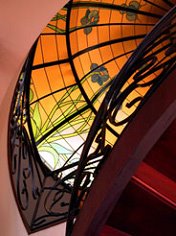Brussels: Dossier ART NOUVEAU

As well as being a city for shoppers, gourmets and museum enthusiasts, Brussels boasts a great artistic legacy from its period as one of the main centres of the Art Nouveau world, with a plethora of Art Nouveau architecture and treasures that can be visited on full-day themed tours or on independent walks along the streets and fashionable districts of the Belgian capital.
The movement flourished in Belgium from 1893 until the First World War and was initially based on the use of arabesque and naturalist decorations.
Enough survives of its buildings and decorative designs to merit a visit, and the varying styles of the movement can be seen in façades and interiors of buildings throughout the capital. Watch out for the intricate wrought-iron balconies, round windows, and frescoes that were employed in combination to give buildings an ‘hallucinogenic' look!
Victor Horta was the main architect and precursor of Art Nouveau, and shared his ideas with other important figures such as Hankar, Strauven, Blérot, and the Delune brothers. The central areas of Ixelles and St. Gilles boast the densest concentration of Art Nouveau buildings from these architects. Horta's work, known for its swirling ironwork, elaborate masonry and revolutionary use of natural light, can be seen at his former home, now the Horta Museum.
It is a superb introduction to the late nineteenth century movement and represents typical examples of the style, with airy rooms radiating from an iron-laced staircase, mirrored walls, glorious timber panelling, intimate stained-glass inlays and even curled door handles.
About a decade later, Horta constructed the Maison du Peuple (People's House) in order to open up a light-filled space to people living in the slums. You can go on a tour of the site that was designed as an entertainment venue for the ‘common' people and was built on the place Vandervelde. It was abandoned in 1965, but parts of the building, like its wrought-iron railings and bricks, have been used at a variety of underground stations around the capital, like Gare Centrale and Horta
Some other Horta highlights include the Hôtel Solvay and the Hôtel Tassel that were both commissioned by wealthy families for their private residences. Others include the Maison Sander Pierron that is famous for its sets of differently coloured bricks, and the Hôtel Dubois that contains a succession of beautifully shaped picture windows above the entrance door. The Hôtel Hannon is also well-known for its stone frieze and stained-glass windows that were created in 1902 by Jules Brunfaut. Another of the movement's leading figures was Henri Van de Velde who created the famous Belgian Railways logo and the Bloemenwerf house. This personal villa was centred on a two-storey hall with curved lights.
The famous European Union district of Brussels also contains many examples of Art Nouveau, namely the Maison St-Cyr on Square Ambiorix, which was built by the architect Strauven and is famous for its coloured brick-work and numerous curved window panes. West from here is the house of Van Eetvelde at avenue Pamerston. The interior is a Horta masterpiece, with a central dome infused with plant motifs. Close to the Parc du Cinquantenaire is the 1905 Maison Cauchie at rue des Francs that was the home of the architect and painter Cauchie. It is now owned by the founder of The Belgian Centre for Comic Strip Art, which was once the Grand Magasin Waucquez, a department store in Art Nouveau style created by Horta in 1906. Other Art Nouveau style museums include the Museum of Musical Instruments (MIM), also housed in a former department store and built in 1899 by Paul Saintenoy.
Its black façade is a swirl of wrought iron and arched windows. The architecture of the Palais des Beaux-Arts (Centre for Fine Arts) is the work of Horta and holds many temporary Art Nouveau exhibitions.
In 2005 the long-awaited opening of the Clockarium museum will have no fewer than 1,000 china mantelpiece ornaments from the Art Nouveau period on display, and from June 2005 there will be an exhibition entitled “Art Nouveau: at the heart of design in Belgium, 1830-1958” at the Royal Museum of Art and History, with 250 works illustrating the development of Belgian design, with Art Nouveau as the focal point.
As well as private homes and public buildings, a whole range of restaurants and cafés were designed by Art Nouveau architects. Le Cirio, for example, is a sumptuous grand café dating from 1886 with an opulent interior and old-fashioned aproned waiters. And don't forget Ultimate Hallucination, built in 1904 by the architect Paul Harnesse, and the Restaurant Falstaff , which is popular with the fashionable young and eccentric old. A la Mort Subite in the city centre and the brasserie La Porteuse D'eau in St. Gilles are also favourites to admire at the end of your sightseeing extravaganza.


1 Comments:
I really enjoyed looking at your site, I found it very helpful indeed, keep up the good work.
»
Post a Comment
<< Home